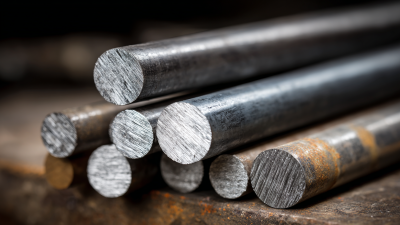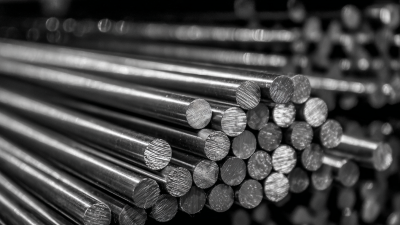2025 Top 5 Cemented Carbide Round Bars for Enhanced Durability and Performance in Industrial Applications
In the ever-evolving landscape of industrial applications, durability and performance remain paramount considerations for manufacturers and engineers alike. Cemented carbide round bars have emerged as a critical component in various applications due to their exceptional hardness and wear resistance. According to a report by Markets and Markets, the global cemented carbide market is projected to reach USD 36.31 billion by 2025, driven by increasing demand for high-performance materials in sectors such as aerospace, automotive, and metalworking.
Cemented carbide round bars, characterized by their unique microstructure and superior mechanical properties, offer solutions that enhance the efficacy of tools and components used in demanding environments. A study published by Research and Markets highlights that the demand for cemented carbide tools is set to grow at a CAGR of 5.2% from 2020 to 2025, underscoring their vital role in manufacturing efficiency and productivity. As industries strive for higher output and longevity of their tools, understanding the top five cemented carbide round bars capable of delivering enhanced durability becomes essential for informed decision-making in material selection.

Top 5 Features of Cemented Carbide Round Bars for Industrial Use
Cemented carbide round bars have become essential in various industrial applications due to their outstanding durability and performance. The first key feature is their exceptional hardness, which allows them to withstand significant wear and tear. This characteristic is pivotal in industries such as mining and metalworking, where tools are subjected to extreme conditions. Additionally, their high resistance to heat prevents deformation, ensuring longevity in demanding environments.
Another important feature is their versatility. Cemented carbide round bars can be manufactured in various grades, tailored to specific applications. This adaptability makes them suitable for use in a range of tools, including drills, inserts, and wear parts. Moreover, they exhibit superior corrosion resistance, which is essential in industries exposed to harsh chemicals and prolonged moisture.
Tip: When selecting cemented carbide round bars, consider the specific environmental conditions they will face. Matching the grade of carbide to the operational demands can significantly enhance performance. Furthermore, regular maintenance of tools made from these materials can prolong their lifespan, ensuring optimal performance over time. Always consult with suppliers for recommendations based on your unique requirements.
Advantages of Using Cemented Carbide Over Traditional Materials
Cemented carbide materials, known for their impressive hardness and wear resistance, are increasingly being favored over traditional materials in industrial applications. The use of cemented carbide enhances durability significantly, particularly in demanding environments. According to market reports, the global cemented carbide market is projected to grow at a CAGR of 5.8% from 2021 to 2026, driven by advancements in manufacturing technologies and increased demand in sectors such as machining, mining, and construction.
One of the pioneering advancements in cemented carbide technology is the application of pulsed magnetic treatment, which has been shown to improve the anti-tribological properties of YG8 cemented carbide, thereby increasing its wear resistance. This innovation is crucial for industries where material performance can significantly impact productivity and cost-efficiency. Furthermore, the exploration of using CO2 to create concrete presents exciting opportunities for enhancing the sustainability of cemented carbide production processes.
**Tips:** When considering material options for industrial applications, prioritize those with enhanced wear resistance and durability, such as cemented carbide, to optimize operational efficiency. Additionally, staying informed about emerging technologies like pulsed magnetic treatment can provide competitive advantages in material selection.

Key Factors Influencing the Performance of Round Bars in Manufacturing
The performance of cemented carbide round bars in industrial applications is influenced by several key factors that manufacturers must consider. Firstly, the material composition plays a crucial role; specifically, the ratio of tungsten carbide to cobalt can determine the hardness and wear resistance of the bars. A higher tungsten carbide content typically enhances durability, making the bars more suitable for demanding machining tasks. Additionally, the grain size of the carbide particles affects toughness and performance, where finer grains can lead to improved wear resistance and strength.
Another significant factor is the manufacturing process itself. The sintering temperature and time can greatly influence the final properties of the round bars. Proper control of these parameters ensures optimal densification, leading to enhanced mechanical characteristics. Furthermore, surface treatment techniques, such as coating and grinding, can provide additional benefits by reducing friction and improving resistance to corrosion. By understanding and optimizing these factors, manufacturers can produce high-performance cemented carbide round bars that meet the rigorous demands of industrial applications.
2025 Top 5 Cemented Carbide Round Bars for Enhanced Durability and Performance in Industrial Applications
| Grade |
Diameter (mm) |
Tensile Strength (MPa) |
Hardness (HRA) |
Wear Resistance |
Applications |
| K10 |
10 |
500 |
90 |
High |
Cutting Tools |
| K20 |
12 |
600 |
91 |
Very High |
Precision Machining |
| K30 |
16 |
700 |
92 |
Extremely High |
Oil & Gas Drilling |
| K40 |
20 |
800 |
93 |
Ultra High |
Mining Equipment |
| K50 |
25 |
900 |
94 |
Phenomenal |
Aerospace Components |
Innovative Applications of Cemented Carbide in Various Industries
Cemented carbide has become a cornerstone material in various industrial applications due to its exceptional hardness and wear resistance. According to a report by Research and Markets, the global cemented carbide market is expected to grow at a CAGR of 5.1% from 2023 to 2028, driven by the increasing demand in automotive, aerospace, and mining industries. The unique properties of cemented carbides, such as their ability to withstand high temperatures and pressures, make them ideal for cutting tools, wear parts, and other applications where durability is paramount.
In the automotive industry, cemented carbide is increasingly being used for manufacturing components such as valve seats and turbocharger parts. The ability of cemented carbide to maintain performance under extreme conditions allows for longer service life and reduced maintenance costs. Similarly, in the oil and gas sector, cemented carbide drill bits are essential for enhanced penetration rates and operational efficiency, contributing to a significant reduction in drilling costs.
With ongoing advancements in material science, the innovative applications of cemented carbide are set to expand, offering enhanced performance and reliability across multiple sectors.
Future Trends in Cemented Carbide Technology for Enhanced Durability
The future of cemented carbide technology is poised for significant advancements aimed at enhancing durability and performance in industrial applications. One of the key trends is the ongoing development of advanced composite materials that combine cemented carbide with other high-performance alloys. This hybridization not only improves wear resistance but also effectively reduces brittleness, leading to longer tool life and increased efficiency in machining processes.

Additionally, the integration of smart technologies into cemented carbide manufacturing is on the rise. The use of real-time monitoring systems can optimize production parameters, ensuring consistent quality and performance of the round bars. Moreover, the application of artificial intelligence in material design is facilitating the creation of tailor-made carbide compositions that meet specific demands of various industries, including automotive and aerospace. These innovations promise not only to enhance performance but also to reduce environmental impact through more sustainable manufacturing practices.

Home
About Us
Products
Solid Carbide Rods
Carbide Rods with coolant holes
Carbide Rods with Two Helix Holes
Tungsten Carbide Flats
Solid Carbide Discs
Tungsten Carbide anti-vibration cylindrical shafts
Non-standard Customized Carbide Blanks
Solid Carbide Circular Saw Blade
Solid Carbide Woodworking Blade
Solide Carbide End Mills
Solid Carbide Drills
Carbide Rotary Burrs
Customized Carbide Tools
News
FAQS
Contact Us








